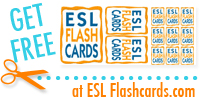Quote:
|
Quote williejean Hi Everyone:
I have to give a report on how I would teach comparative adjectives to a group of students, aged 12-15 (low intermediate) My theme is food. I did a cloze activity but need a lot more ideas. The food is pizza, hamburger, french fries, candy, sandwiches and tacos. I know, strange, but we have to stick with the same theme we have been using before just now have to teach a new grammar point.
Thanks for any help you may give me. |
It's a yucky theme to use for teaching this area, mainly because most of the adjs which you can use to talk about it are a) fairly advanced b) not easy to depict visually - so it is very difficult to demonstrate the meaning. However, if they're lower int, then I'm presuming that they'll at least have met the word
more before- which is a good starting point. What follows is not how I'd do it personally, but I'd never choose that context. If you're stuck with it, what about .....
Can't you add in some healthy food and use the theme of health???
You need to cover :
- one syllable adjs + -er : quicker to make
- 2 syll adjs ending in y : healthier, easier to cook, tastier, spicier,
- Other 2 syll adjs : -er or more : simpler to make, more common
- 3+ syll adjectives + more : more fattening, more expensive
- irregulars : better / worse for your health
Presentation :
- Pics of foods - check knowledge of food and base adjective - What's this? It's an apple. Are apples good for your health or bad for your health? Are they fattening? (use gesture), and so on for all the others. Check also that Ss understand the concept of syllables and can count the syllables in each adjective - use gesture or beat it out to indicate it if necessary.
- At that point you can bring in the comparatives with more : OK, so apples aren't fattening, but French fries are very fattening. So, French fries are more fattening than apples. etc
I'd start just with 3 syllable adjs and then move on to the 1 syllable adjs, possibly with the irregulars too. If you want to analyse the grammar (at 12 I would start to and by 15 certainly) check their understanding of the rules at this point. Do a short repetition drill and then a receptive practice activity : Say -
if you think hamburgers are nicer than pizza, stand up. If you think apples are worse for your teeth than sweets, sit on the desk. If you think french fries are more fattening than sweets, touch something yellow. etc. The Ss have to listen, understand and do whatever is relevant. Then do an ex on those adjs before going on to the others. Ss have the key words
sandwiches / pizza / quick to make. and have to make sentences.
Once you're sure that they've understood those, bring in the first part of a reading text on healthy/unhealthy food with adjs from all the groups in it. Ask students to underline all the comparatives and then to group them. They know that 1 sylls are
-er and 3+sylls are
more, but what about the 2 sylls. They find them, then work out that they're sometimes one and sometimes the other. You can then ask
What happens to the adjs which end in -y? and point out that they're always
-er. You'd then need another ex to practise all the adjectives together.
In the above, I'm presuming it's an initial presentation, though that's strange for lower int. level. If it's actually a remedial presentation, then you can risk bringing in all the categories from the beginning. In that case I'd start by asking the students about their favourite foods and if they're good/bad for them, healthy, fattening etc. That will lead into the introduction of the comparisons, and you can then follow up with the receptive practice activity, the sentence making ex and the gapped text with the adjs in brackets.










 Linear Mode
Linear Mode




